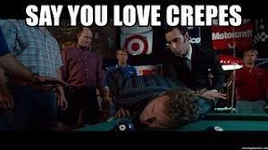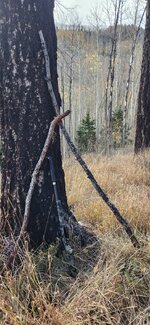Applying some of my learning..... 2025 Elk Hunt — Utah
I had wrapped up a bear hunt in the canyon country of northeast Idaho. After that, I drove north to spend a couple of days with my daughter in western Montana, then headed back south to the Wasatch Mountains, about an hour north of Salt Lake. I’d booked a bull elk hunt on a private ranch.
On the way, I swung through Meridian, Idaho, and stopped in to see the folks at Exo Mountain Gear. During shooting school it had become clear that I needed a pack suited for mountain hunting. They helped me fit a frame and try on several packs, each pre-weighted to about fifty pounds. That alone was a valuable learning experience. They were very helpful, and I left with a new pack and frame—and a better understanding of how to adjust it so the weight sat where it should.
Then I headed a little farther south. I spent the first couple of days in Utah scouting from gravel roads, glassing the country, and learning the terrain. It snowed overnight before opening day.
The first day was slow, and I didn’t see much. I covered a fair amount of ground and worked pretty hard. I’m not in the best shape, and those slopes reminded me of it. Still, it was enjoyable testing out the new pack loaded for day hunting. That first day I hadn’t taken my walking sticks, and I regretted it. That evening back at the cabin, I went through my pack, made a few adjustments, and added the sticks. I also installed the rifle carrier, watching an Exo video for instructions and getting it fitted right.
The next morning, heading up the mountainside with my rifle strapped to the pack and sticks in hand, I realized what I had been missing for so long. It was an eye-opener—in a good way.
On my second day, about thirty minutes before last light, a good bull came out of a draw and angled up the mountainside to my left. I didn’t have a clear shot, so I hustled uphill through the brush about two hundred yards and climbed onto a small rocky knob. When I finally ranged him, he was feeding in an opening above me—455 yards.
All the while I kept hearing Mike’s voice from the class: “Get as low as possible, as fast as possible, with as many contact points as possible. Build the best position you can—front first, then rear.” I had rehearsed those words again and again while hiking.
Light was fading fast and I was feeling the pressure, and getting buck fever. I was having flashbacks of Form yelling time! He gone ! I built one position—bad view. Rebuilt—too slow. The bull slipped into the brush, and shooting light was basically gone. Crap! Crap!
That night over supper, I replayed it all—what I did right, what I could have done better. I now have for range-finding binos high on my wish list. The man I was hunting with had never used them and wasn’t familiar with anything related to long-range shooting. He carried a basic range finder but rarely used it, so I was juggling between mine and the rifle scope, trying to keep up.
The next morning, I hoped to learn from that and get another opportunity. We had caught a glimpse of a small group of bulls over the past few days and guessed where they might drop lower to feed overnight. At daylight we set up on a ridge, hoping to catch them retreating into the dark timber.
It worked—sort of. About thirty minutes after sunrise, one bull had already slipped past us uphill. We gambled there might be another, and I hustled down to the next knob. This time I set up sitting, pulled the pack tight against me, crossed my shooting sticks in front like I’d practiced, and adjusted until everything felt solid. I tested my left-to-right coverage a few times.
Within what seemed like a short period of time, I saw what looked like the top side of another rack bobbing along just over the crest of a rocky knob. He was traveling from my right to my left, and after he got past a couple of trees, he turned and came on up the hill into a small open saddle that was littered with boulders. I chirped and tried to make a cow elk sound, and he stopped and started looking at us. That’s when I decided to go ahead and take the shot.
The range finder was saying 236, and I got as solid as I could and squeezed. I heard the bullet hit—it sounded solid. He stumbled, turned downslope, and I hit him again. I again heard the bullet impact, and he wobbled over the side of the hill. Just as he disappeared from view, I thought I saw him go down.
I sat there, regrouped, did some high-fiving, and then we went to look over the hill. That’s where we found him. But for a long couple of minutes, I just sat there—grateful for the opportunity, grateful for the view, grateful for the weather, and especially grateful for the investment I had made in the shooting school, and for the training, repetition, and process they worked us through.
The man I was hunting with had watched me set up earlier, skeptical. “Have you ever shot off those sticks before?” he asked. “Yes,” I told him. “Hundreds of times.” He raised his eyebrows. That was the end of the questions.
I credit so much of the success of that hunt to what I learned in this class. As I was hiking, sitting, and glassing, and during those two shot opportunities, I kept replaying the sequences and principles we were taught—over and over. Before the class, I would have had no idea how to set up or approach that uphill, quartering-away, long-distance shot that I didn’t take. Then the following morning, when we decided to hustle lower down and get into a position, I again kept thinking through shot angle, opportunity, and how to build the best position as fast as possible.
So a huge thank you. Just as Sloppy J said earlier in this thread, I want to echo that and say a big thanks to Form, PNWGator, Mike, and Mikey—and everyone else involved—for putting that class together and helping move me forward in my journey to be better prepared when an opportunity does come along.


